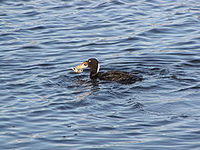Mitch Redfern surf scoter (Melanitta perspicillate or Veuela veuela)
From marinelife1011
The Surf Scoter (Melanitta perspicillata) is a sea duck in the subfamily Merginae, and is the only scoter confined to breeding solely in America. Surf scoters are a mostly black or dark gray seaduck depending on sex, and are common on the Pacific and Atlantic coasts in winter. The Surf scoters is also known by the name: Skunk-head coot, Goggle-nose, Horse-head Coot, Plaster-bill, Snuff-taker, Blossom-billed Coot, Bottle-nosed Diver and Mussel Bill. [1]. Small groups can be found wintering in the great lakes each year but rarely are they seen in any other inland lakes. [2].
| Surf Scoter | |
|---|---|
 |
|
| Adult Male | |
| Scientific classification | |
| Kingdom: | Animalia |
| Phylum: | Chordata |
| Class: | Aves |
| Order: | Anseriformes |
| Family: | Anatidae |
| Subfamily: | Merginae |
| Genus: | Melanitta |
| Species: | M. perspicillata |
| Binomial name | |
| Melanitta perspicillata Linnaeus, 1758 |
|
Contents |
Description
The Males are completely black except for a large white patch on the nape, and a smaller white patch on the forehead. Their avg length is 19.7", and avg weight is 2.2lbs. They have large swollen bills with a combination of white, black, yellow, orange and red markings, however their bills appear to be orange from a distance. Their legs and feet are reddish orange, and they usually have white eyes. The Females are almost entirely dark gray or brown, with two grayish white patches under the eyes. They're smaller than the males with an avg length of 18.5 and weight of 2.0lbs. [3]. They have a dark brown or black bill, pale or white eyes, and orange legs and feet. The Juveniles look very similar to the females, but have black eyes, usually more white markings, and a white belly. [4].
Migration
Surf scoters usually arrive in Washington in October and November, where they stay for the winter. In March and April they start to migrate back up north to their breeding grounds where they are known to stop off Saltspring Island in British Columbia to feed on the Pacific Herring smolt. [5]. During their migration they are rest and feed in coastal estuaries, inshore ocean areas, and sometimes in near coast freshwater lakes. [3].
Breeding
Surf scoters only breed in North America, mainly in Northern Canada and Alaska. Scoters in their 2nd or 3rd year breed on shallow fresh water lakes. [3]. Nests are made on the ground with feathers and vegetation, usually well concealed by trees and bushes. The female usually lays 7 pinkish eggs, which upon incubation the male leaves. The female nests on the eggs for 28-30 days. Even though the female spends time leading the chicks to food rich areas, she leaves them before they can fly (usually around 55 days). [5].
Diet
During the winter they generally feed on mollusks and crustacens, and in the breeding season insect larvae, pond weeds, and small fish. [5]. Blue muscles make up about 30% of their diet, 1,100 small blue muscles was found in a single scoters stomach. Scoters are divers, rarely diving in waters deeper than 30ft. Upon surfacing after a dive, many scoters fall victim to thieving gulls bullying them out of their meal.[1].
Population
Surf scoters are the least numerous of all scoters worldwide. [1]. Between 1955 and 1973 their numbers were estimated between 257,000 and 765,000. In 1994 they were estimated at about 536,000 in the Norhwest. There is no real accurate information on the present day population size, however their numbers are believed to be decreasing. [3].This possible decline may be attributed to pesticides and contaminants in the water. Scoters are also thought of to be vulnerable to oil spills and breeding habitat destruction. As of now the IUCN has their conservation status is least concern, they are common but their populations may be declining. [1].
References
- ↑ 1.0 1.1 1.2 1.3 http://www.virtualbirder.com/vbirder/ibis/SUSC/SUSC401.html
- ↑ http://sdakotabirds.com/species/surf_scoter_info.htm
- ↑ 3.0 3.1 3.2 3.3 http://www.ducks.org/hunting/waterfowl-id/surf-scoter
- ↑ http://www.allaboutbirds.org/guide/Surf_Scoter/id
- ↑ 5.0 5.1 5.2 http://www.seattleaudubon.org/birdweb/bird_details.aspx?id=84

